Soil Erosion Characteristics and Scenario Analysis in the Yellow River Basin Based on PLUS and RUSLE Models
Abstract
1. Introduction
2. Materials and Methods
2.1. Study Area
2.2. Data Sources
2.3. RUSLE Model
2.3.1. Rainfall Erosivity Factor (R)
2.3.2. Soil Erodibility Factor (K)
2.3.3. Slope Length (L) and Steepness (S) Factors
2.3.4. Cover Management Factor (C)
2.3.5. Conservation Measure Factor (P)
2.4. Land-Use Change Matrix (LUCM)
2.5. PLUS Model
- (1)
- We extract the land use expansion from 2000 to 2020 according to the land expansion module in the PLUS software. Then, combined with the land expansion analytical strategy module, 12 driving factors are selected, including elevation, slope, aspect, annual average precipitation, annual average temperature, GDP, population, distance from expressway, distance from railway, distance from main roads, and distance from water area and soil type, to generate the development probability of each type of land.
- (2)
- Based on the CA module which is based on multi-class random patch seeds in the PLUS software, the land development probability obtained in the previous step is taken as the basic condition, and then the water area is set as the restricted development condition to obtain the diffusion coefficient. Finally, the domain weight is calculated according to the proportion of the expansion area of each land type. At the same time, two change scenarios of natural development and ecological protection are established.
- (3)
- We select the year 2000 as the base start time and use the development probability of each land use from 2000 to 2020 to predict the land use in 2020. The verification module in the PLUS software is used to input the actual land use data and predict land use data in 2020, and its results are verified by Kappa coefficient to evaluate the simulation results. On this basis, we further simulate land use under the natural development scenario and the ecological protection scenario in 2040. The simulation results are used to calculate the P factor of RUSLE, because this factor is greatly affected by human activities. By predicting land use, and then predicting soil erosion under the influence of human activities, the relationship between land-use change and soil erosion is discussed.
3. Results
3.1. Analysis of SE Temporal and Spatial Characteristics
3.2. Links between SE and Land-Usage Alteration
3.3. Analyses of Future SE under Various Scenarios
4. Discussion
4.1. Major Finding and Result Comparison
4.2. Land-Use Change and Soil Erosion under Different Scenarios in the Future
4.3. Limitations of This Study
5. Conclusions
Author Contributions
Funding
Institutional Review Board Statement
Informed Consent Statement
Data Availability Statement
Conflicts of Interest
References
- Amundson, R.; Berhe, A.A.; Hopmans, J.W.; Olson, C.; Sztein, A.E.; Sparks, D.L. Soil and human security in the 21st century. Science 2015, 348, 1261071. [Google Scholar] [CrossRef]
- Zhang, P.Y.; Qin, C.Z.; Hong, X.; Kang, G.H.; Qin, M.Z.; Yang, D.; Pang, B.; Li, Y.Y.; He, J.J.; Dick, R.P. Risk assessment and source analysis of soil heavy metal pollution from lower reaches of Yellow River irrigation in China. Sci. Total Environ. 2018, 633, 1136–1147. [Google Scholar] [CrossRef] [PubMed]
- Borrelli, P.; Robinson, D.A.; Fleischer, L.R.; Lugato, E.; Ballabio, C.; Alewell, C.; Meusburger, K.; Modugno, S.; Schütt, B.; Ferro, V.; et al. An assessment of the global impact of 21st century land use change on soil erosion. Nat. Commun. 2017, 8, 2013. [Google Scholar] [CrossRef] [PubMed]
- Wan, W.; Liu, Z.; Li, B.G.; Fang, H.Y.; Wu, H.Q.; Yang, H.Y. Evaluating soil erosion by introducing crop residue cover and anthropogenic disturbance intensity into cropland C-factor calculation: Novel estimations from a cropland-dominant region of Northeast China. Soil Tillage Res. 2022, 219, 105343. [Google Scholar] [CrossRef]
- Sartori, M.; Philippidis, G.; Ferrari, E.; Borrelli, P.; Lugato, E.; Montanarella, L.; Panagos, P. A linkage between the biophysical and the economic: Assessing the global market impacts of soil erosion. Land Use Policy 2019, 86, 299–312. [Google Scholar] [CrossRef]
- Liu, M.; Han, G.L.; Giese, M.; Li, X.Q.; Zhang, S.T.; Zhou, W.X.; Zhang, Q. Effects of Soil Properties on K Factor in the Granite and Limestone Regions of China. Int. J. Environ. Res. Public Health 2020, 17, 801. [Google Scholar] [CrossRef]
- Song, X.P.; Hansen, M.C.; Stehman, S.V.; Potapov, P.V.; Tyukavina, A.; Vermote, E.F.; Townshend, J.R. Global land change from 1982 to 2016. Nature 2018, 560, 639–643. [Google Scholar] [CrossRef]
- Zhang, P.Y.; Yang, D.; Qin, M.Z.; Jing, W.L. Spatial heterogeneity analysis and driving forces exploring of built-up land development intensity in Chinese prefecture-level cities and implications for future Urban Land intensive use. Land Use Policy 2020, 99, 104958. [Google Scholar] [CrossRef]
- Chen, Z.J.; Wang, L.; Wei, A.S.; Gao, J.B.; Lu, Y.L.; Zhou, J.B. Land-use change from Croplands to orchards reduced soil erosion and increased nutrient loss in a small catchment. Sci. Total Environ. 2019, 648, 1097–1104. [Google Scholar] [CrossRef] [PubMed]
- Feng, T.J.; Wei, W.; Chen, L.D.; Rodrigo-Comino, J.; Die, C.; Feng, X.R.; Ren, K.M.; Brevik, E.C.; Yu, Y. Assessment of the impact of different vegetation patterns on soil erosion processes on semiarid loess slopes. Earth Surf. Process. Landf. 2018, 43, 1860–1870. [Google Scholar] [CrossRef]
- Gilani, H.; Ahmad, A.; Younes, I.; Abbas, S. Impact assessment of land cover and land use changes on soil erosion changes (2005–2015) in Pakistan. Land Degrad. Dev. 2022, 33, 204–217. [Google Scholar] [CrossRef]
- Gao, Q.; Yu, M.; Ci, L.J. Modeling wind and water erosion in northern China under climate and land use changes. J. Soil Water Conserv. 2002, 57, 46–55. [Google Scholar]
- West, P.C.; Gerber, J.S.; Engstrom, P.M.; Mueller, N.D.; Brauman, K.A.; Carlson, K.M.; Cassidy, E.S.; Johnston, M.; MacDonald, G.K.; Ray, D.K.; et al. Leverage points for improving global food security and the environment. Science 2014, 345, 325–328. [Google Scholar] [CrossRef]
- Seutloali, K.E.; Beckedahl, H.R. A review of road-related soil erosion: An assessment of causes, evaluation techniques and available control measures. Earth Sci. Res. J. 2015, 19, 73–80. [Google Scholar] [CrossRef]
- Fox, J.; Vogler, J.B.; Sen, O.L.; Giambelluca, T.W.; Ziegler, A.D. Simulating land-cover change in montane mainland Southeast Asia. Environ. Manag. 2012, 49, 968–979. [Google Scholar] [CrossRef] [PubMed]
- Panagos, P.; Borrelli, P.; Poesen, J.; Ballabio, C.; Lugato, E.; Meusburger, K.; Montanarella, L.; Alewell, C. The new assessment of soil loss by water erosion in Europe. Environ. Sci. Policy 2015, 54, 438–447. [Google Scholar] [CrossRef]
- Yan, R.; Zhang, X.P.; Yan, S.J.; Chen, H. Estimating soil erosion response to land use/cover change in a catchment of the Loess Plateau, China. Int. Soil Water Conserv. Res. 2018, 6, 13–22. [Google Scholar] [CrossRef]
- Wischmeier, W.H.; Smith, D.D. Predicting Rainfall Erosion Losses: A Guide to Conservation Planning; Department of Agriculture, Science and Education Administration: Washington, DC, USA, 1978. [Google Scholar]
- Renard, K.G.; Foster, G.R.; Weesies, G.A.; Porter, J.P. RUSLE: Revised Universal Soil Loss Equation. J. Soil Water Conserv. 1991, 46, 30–33. [Google Scholar]
- Morgan, R.P.C.; Quinton, J.N.; Smith, R.E.; Govers, G.; Poesen, J.W.A.; Auerswald, K.; Chisci, G.; Torri, D.; Styczen, M.E. The European soil erosion model (EUROSEM): A dynamic approach for predicting sediment transport from fields and small catchments. Earth Surf. Process. Landf. 1998, 23, 527–544. [Google Scholar] [CrossRef]
- Liu, B.Y.; Nearing, M.A.; Risse, L.M. Slope length effects on soil loss for steep slopes. Soil Sci. Soc. Am. J. 2000, 64, 1759–1763. [Google Scholar] [CrossRef]
- Onori, F.; Bonis, P.D.; Grauso, S. Soil erosion prediction at the basin scale using the revised universal soil loss equation (RUSLE) in a catchment of Sicily (southern Italy). Environ. Geol. 2006, 50, 1129–1140. [Google Scholar] [CrossRef]
- Humphrey, O.S.; Osanob, O.; Aura, C.M.; Marriotta, A.L.; Dowell, S.M.; Blaked, W.H.; Watts, M.J. Evaluating spatio-temporal soil erosion dynamics in the Winam Gulf catchment, Kenya for enhanced decision making in the land-lake interface. Sci. Total Environ. 2022, 815, 15197. [Google Scholar] [CrossRef] [PubMed]
- Feng, T.; Chen, H.S.; Polyakov, V.O.; Wang, K.; Zhang, X.B.; Zhang, W. Soil erosion rates in two karst peak- cluster depression basins of northwest Guangxi, China: Comparison of the RUSLE model with 137Cs measurements. Geomorphology 2016, 253, 217–224. [Google Scholar] [CrossRef]
- Xu, E.R.; Zhang, H.Q. Change pathway and intersection of rainfall, soil, and land use influencing water-related soil erosion. Ecol. Indic. 2020, 113, 106281. [Google Scholar] [CrossRef]
- Wang, Y.C.; Zhao, J.; Fu, J.W.; Wei, W. Effects of the grain for green program on the water ecosystem services in an arid area of China: Using the Shiyang River Basin as an example. Ecol. Indic. 2019, 104, 659–668. [Google Scholar] [CrossRef]
- Wang, J.T.; Peng, J.; Zhao, M.Y.; Liu, Y.X.; Chen, Y.Q. Significant trade-off for the impact of Grain-for-Green programme on ecosystem services in North-western Yunnan, China. Sci. Total Environ. 2017, 574, 57–64. [Google Scholar] [CrossRef]
- Chen, H.; Marter-Kenyon, J.; Lopez-Carr, D.; Liang, X.Y. Land cover and landscape changes in Shaanxi Province during China’s Grain for Green Program (2000–2010). Environ. Monit. Assess. 2015, 187, 644. [Google Scholar] [CrossRef]
- Li, G.Y.; Jiang, C.H.; Zhang, Y.H.; Jiang, G.H. Whether land greening in different geomorphic units are beneficial to water yield in the Yellow River Basin? Ecol. Indic. 2021, 120, 106926. [Google Scholar] [CrossRef]
- Geng, W.L.; Li, Y.Y.; Zhang, P.Z.; Yang, D.; Jing, W.L.; Rong, T.Q. Analyzing spatio-temporal changes and trade-offs/synergies among ecosystem services in the Yellow River Basin, China. Ecol. Indic. 2022, 138, 108825. [Google Scholar] [CrossRef]
- Jiang, W.G.; Yuan, L.H.; Wang, W.J.; Cao, R.; Zhang, Y.F.; Shen, W.M. Spatio-temporal analysis of vegetation variation in the Yellow River Basin. Ecol. Indic. 2015, 51, 117–126. [Google Scholar] [CrossRef]
- Zeng, C.; Wang, S.J.; Bai, X.Y.; Li, Y.Y.; Tian, Y.C.; Li, Y.; Wu, L.H.; Luo, G.J. Soil erosion evolution and spatial correlation analysis in a typical karst geomorphology using RUSLE with GIS. Solid Earth 2017, 8, 721–736. [Google Scholar] [CrossRef]
- Bai, X.Y.; Zhang, X.B.; Long, Y.; Liu, X.M.; Siyu, Z. Use of 137 Cs and 210 Pbex measurements on deposits in a karst depression to study the erosional response of a small karst catchment in Southwest China to land-use change. Hydrol. Process. 2013, 27, 822–829. [Google Scholar] [CrossRef]
- Marcinkowski, P.; Wasilewska, S.S.; Kardel, I. Assessment of soil erosion under long-term projections of climate change in Poland. J. Hydrol. 2022, 607, 127468. [Google Scholar] [CrossRef]
- Yesuph, A.Y.; Dagnew, A.B. Soil erosion mapping and severity analysis based on RUSLE model and local perception in the Beshillo Catchment of the Blue Nile Basin, Ethiopia. Environ. Syst. Res. 2019, 8, 17. [Google Scholar] [CrossRef]
- Coulibaly, L.K.; Guan, Q.F.; Assoma, T.V.; Fan, X.; Coulibaly, N. Coupling linear spectral unmixing and RUSLE2 to model soil erosion in the Boubo coastal watershed, Côte d’Ivoire. Ecol. Indic. 2021, 130, 108092. [Google Scholar] [CrossRef]
- Wang, S.; Fang, H.; He, J. Effects of variation in vegetation cover and rainfall on soil erosion in black soil region. Northeast. China Bull. Soil Water Conserv. 2021, 41, 66–75. [Google Scholar]
- Wang, R.; Zhang, S.; Yang, J.; Pu, L.; Yang, C.; Yu, L.; Chang, L.; Bu, K. Integrated use of GCM, RS, and GIS for the assessment of hillslope and gully erosion in the Mushi river sub-catchment, Northeast China. Sustainability 2016, 8, 317. [Google Scholar] [CrossRef]
- Cunha, E.R.D.; Santos, C.A.G.; Silva, R.M.D.; Panachuki, E.; Oliveira, P.T.S.D.; Oliveira, N.D.S.; Falcão, K.D.S. Assessment of current and future land use/cover changes in soil erosion in the Rio da Prata basin (Brazil). Sci. Total Environ. 2022, 818, 151811. [Google Scholar] [CrossRef]
- Panagos, P.; Meusburger, K.; Ballabio, C.; Borrelli, P.; Alewell, C. Soil erodibility in Europe: A high-resolution dataset based on LUCAS. Sci. Total Environ. 2014, 479, 189–200. [Google Scholar] [CrossRef]
- Fenta, A.A.; Tsunekawa, A.; Haregeweyn, N.; Poesen, J.; Tsubo, M.; Borrelli, P.; Panagos, P.; Vanmaercke, M.; Broeckx, J.; Yasuda, H.; et al. Land susceptibility to water and wind erosion risks in the East Africa region. Sci. Total Environ. 2020, 703, 135016. [Google Scholar] [CrossRef] [PubMed]
- Wu, L.; Yao, W.; Ma, X. Using the comprehensive governance degree to calibrate a piecewise sediment delivery ratio algorithm for dynamic sediment predictions: A case study in an ecological restoration watershed of northwest China. J. Hydrol. 2018, 564, 888–899. [Google Scholar] [CrossRef]
- Wischmeier, W.H.; Johnson, C.B.; Cross, B.V. A soil erodibility nomograph for farm-land and construction sites. J. Soil Water Conserv. 1971, 26, 189–193. [Google Scholar]
- Kruk, E.; Klapa, P.; Ryczek, M.; Ostrowski, K. Influence of DEM Elaboration Methods on the USLE Model Topographical Factor Parameter on Steep Slopes. Remote Sens. 2020, 12, 3540. [Google Scholar] [CrossRef]
- McCool, D.K.; Foster, G.R.; Mutchler, C.K.; Meyer, L.D. Revised slope length factor for the universal soil loss equation. Trans. ASAE 1989, 32, 1571–1576. [Google Scholar] [CrossRef]
- Almagro, A.; Thomé, T.C.; Colman, C.B.; Pereira, R.B.; Marcato Junior, J.; Rodrigues, D.B.B.; Oliveira, P.T.S. Improving cover and management factor (C-factor) estimation using remote sensing approaches for tropical regions. Int. Soil Water Conserv. Res. 2019, 7, 325–334. [Google Scholar] [CrossRef]
- Naipal, V.; Ciais, P.; Wang, Y.; Lauerwald, R.; Guenet, B.; Van Oost, K. Global soil organic carbon removal by water erosion under climate change and land use change during AD1850–2005. Biogeosciences 2018, 15, 4459–4480. [Google Scholar] [CrossRef]
- Tamene, L.; Le, Q.B. Estimating soil erosion in sub-Saharan Africa based on landscape similarity mapping and using the revised universal soil loss equation (RUSLE). Nutr. Cycl. Agroecosyst. 2015, 102, 17–31. [Google Scholar] [CrossRef]
- Elnashar, A.; Zeng, H.W.; Wu, B.F.; Fenta, A.A.; Nabil, M.; Duerler, R. Soil erosion assessment in the Blue Nile Basin driven by a novel RUSLE-GEE framework. Sci. Total Environ. 2021, 793, 148466. [Google Scholar] [CrossRef]
- Luo, Y.; Lu, Y.H.; Fu, B.J.; Zhang, Q.J.; Li, T.; Hu, W.Y.; Comber, A. Half century change of interactions among ecosystem services driven by ecological restoration: Quantification and policy implications at a watershed scale in the Chinese Loess Plateau. Sci. Total Environ. 2019, 651, 2546–2557. [Google Scholar] [CrossRef] [PubMed]
- Lufafa, A.; Tenywa, M.M.; Isabirye, M.J.G.; Woomer, P.L. Prediction of soil erosion in a Lake Victoria basin catchment using a GIS-based Universal Soil Loss model. Agric. Syst. 2003, 76, 883–894. [Google Scholar] [CrossRef]
- Lin, F.; Chen, X.W.; Yao, H.X.; Lin, F.Y. SWAT model-based quantification of the impact of land-use change on forest-regulated water flow. Catena 2022, 211, 105975. [Google Scholar] [CrossRef]
- Liang, X.; Guan, Q.F.; Clarke, K.C.; Liu, S.S.; Wang, B.Y.; Yao, Y. Understanding the drivers of sustainable land expansion using a patch-generating land use simulation (PLUS) model: A case study in Wuhan, China. Comput. Environ. Urban Syst. 2021, 85, 101569. [Google Scholar] [CrossRef]
- Li, J.Y.; Gong, J.; Guldmann, J.M.; Yang, J.X.; Zhang, Z. Simulation of Land-Use Spatiotemporal Changes under Ecological Quality Constraints: The Case of the Wuhan Urban Agglomeration Area, China, over 2020–2030. Int. J. Environ. Res. Public Health 2022, 19, 6095. [Google Scholar] [CrossRef]
- Rong, T.Q.; Zhang, P.Y.; Zhu, H.R.; Jiang, L.; Li, Y.Y.; Liu, Z.Y. Spatial correlation evolution and prediction scenario of land use carbon emissions in China. Ecol. Inform. 2022, 71, 101802. [Google Scholar] [CrossRef]
- Liu, S.C.; Shao, Q.Q.; Ning, J.; Niu, L.N.; Zhang, X.Y.; Liu, G.B.; Huang, H.B. Remote-Sensing-Based Assessment of the Ecological Restoration Degree and Restoration Potential of Ecosystems in the Upper Yellow River over the Past 20 Years. Remote Sens. 2022, 14, 3550. [Google Scholar] [CrossRef]
- Fu, B.J.; Liu, Y.; Lu, Y.H.; He, C.S.; Zeng, Y.; Wu, B.F. Assessing the soil erosion control service of ecosystems change in the Loess Plateau of China. Ecol. Complex. 2011, 8, 284–293. [Google Scholar] [CrossRef]
- Deng, L.; Liu, G.B.; Shangguan, Z.P. Land-use conversion and changing soil carbon stocks in China’s Grain-for-Green’ Program: A synthesis. Glob. Chang. Biol. 2014, 20, 3544–3556. [Google Scholar] [CrossRef]
- Li, J.J.; Peng, S.J.; Li, Z. Detecting and attributing vegetation changes on China’s Loess Plateau. Agric. For. Meteorol. 2017, 247, 260–270. [Google Scholar] [CrossRef]
- Xu, Z.C.; Chau, S.N.; Chen, X.Z.; Zhang, J.; Li, Y.J.; Dietz, T.; Wang, J.Y.; Winkler, J.A.; Fan, F.; Huang, B.R.; et al. Assessing progress towards sustainable development over space and time. Nature 2020, 577, 74–78. [Google Scholar] [CrossRef]
- Ouyang, Z.Y.; Zheng, H.; Xiao, Y.; Polasky, S.; Liu, J.G.; Xu, W.H.; Wang, Q.; Zhang, L.; Xiao, Y.; Rao, E.M.; et al. Improvements in ecosystem services from investments in natural capital. Science 2016, 352, 1455–1459. [Google Scholar] [CrossRef]
- Yang, H.F.; Mu, S.J.; Li, J.L. Efects of ecological restoration projects on land use and land cover change and its infuences on territorial NPP in Xinjiang, China. Catena 2014, 115, 85–95. [Google Scholar] [CrossRef]
- Liu, Y.S.; Guo, Y.J.; Li, Y.R.; Li, Y.H. GIS-based efect assessment of soil erosion before and after gully land consolidation: A case study of Wangjiagou project region, Loess Plateau. Chin. Geogr. Sci. 2015, 25, 137–146. [Google Scholar] [CrossRef]
- Bryan, B.A.; Gao, L.; Ye, Y.Q.; Sun, X.F.; Connor, J.D.; Crossman, N.D.; Stafford-Smith, M.; Wu, J.G.; He, C.Y.; Yu, D.Y.; et al. China’s response to a national land-system sustainability emergency. Nature 2018, 559, 193–204. [Google Scholar] [CrossRef] [PubMed]
- Abuzar, M.K.; Shakir, U.; Ashraf, M.A.; Rabia, M.; Sarfraz, K. GIS based risk modeling of soil erosion under different scenarios of land use change in Simly water-shed of Pakistan. J. Himal. Earth Sci. 2018, 51, 132–143. [Google Scholar]
- Alexakis, D.D.; Tapoglou, E.; Vozinaki, A.E.K.; Tsanis, I.K. Integrated Use of Satellite Remote Sensing, Artificial Neural Networks, Field Spectroscopy, and GIS in Estimating Crucial Soil Parameters in Terms of Soil Erosion. Remote Sens. 2019, 11, 1106. [Google Scholar] [CrossRef]
- Liu, X.P.; Ma, L.; Li, X.; Ai, B.; Li, S.Y.; He, Z.J. Simulating urban growth by integrating landscape expansion index (LEI) and cellular automata. Int. J. Geogr. Inf. Sci. 2014, 28, 148–163. [Google Scholar] [CrossRef]
- Liu, J.Z.; Wu, H.J.; Li, S. The Implication of Land-Use/Land-Cover Change for the Declining Soil Erosion Risk in the Three Gorges Reservoir Region, China. Int. J. Environ. Res. Public Health 2019, 16, 1856. [Google Scholar]
- Wei, Y.H.; He, Z.; Jiao, J.Y.; Li, Y.J.; Chen, Y.X.; Zhao, H.K. Variation in the sediment deposition behind check-dams under different soil erosion conditions on the Loess Plateau, China. Earth Surf. Process. Landf. 2018, 43, 1899–1912. [Google Scholar] [CrossRef]
- Guo, L.; Liu, R.; Men, C.; Wang, Q.; Miao, Y.; Shoaib, M.; Wang, Y.F.; Jiao, L.J.; Zhang, Y. Multiscale spatiotemporal characteristics of landscape patterns, hotspots, and influencing factors for soil erosion. Sci. Total Environ. 2021, 779, 146474. [Google Scholar] [CrossRef]
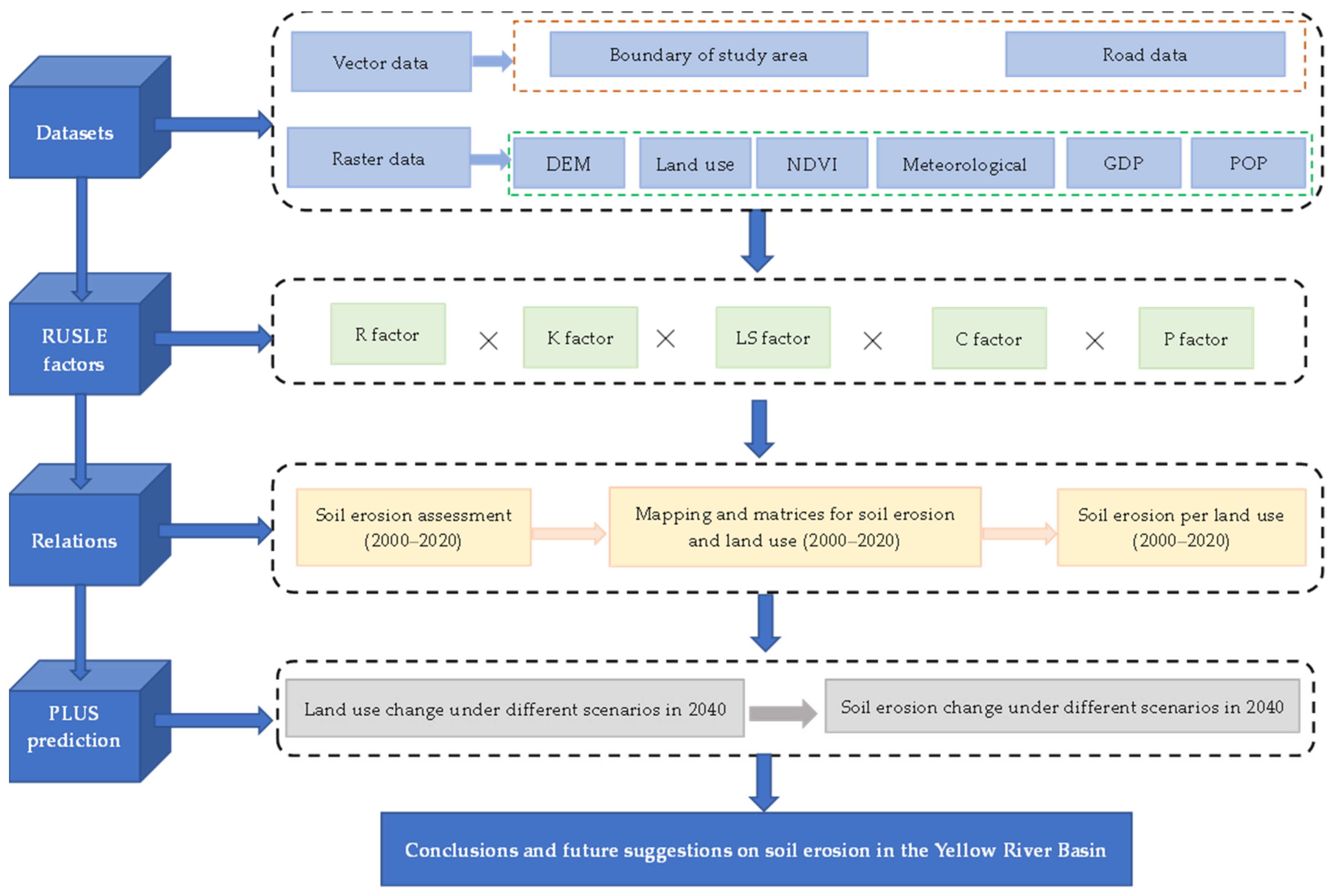
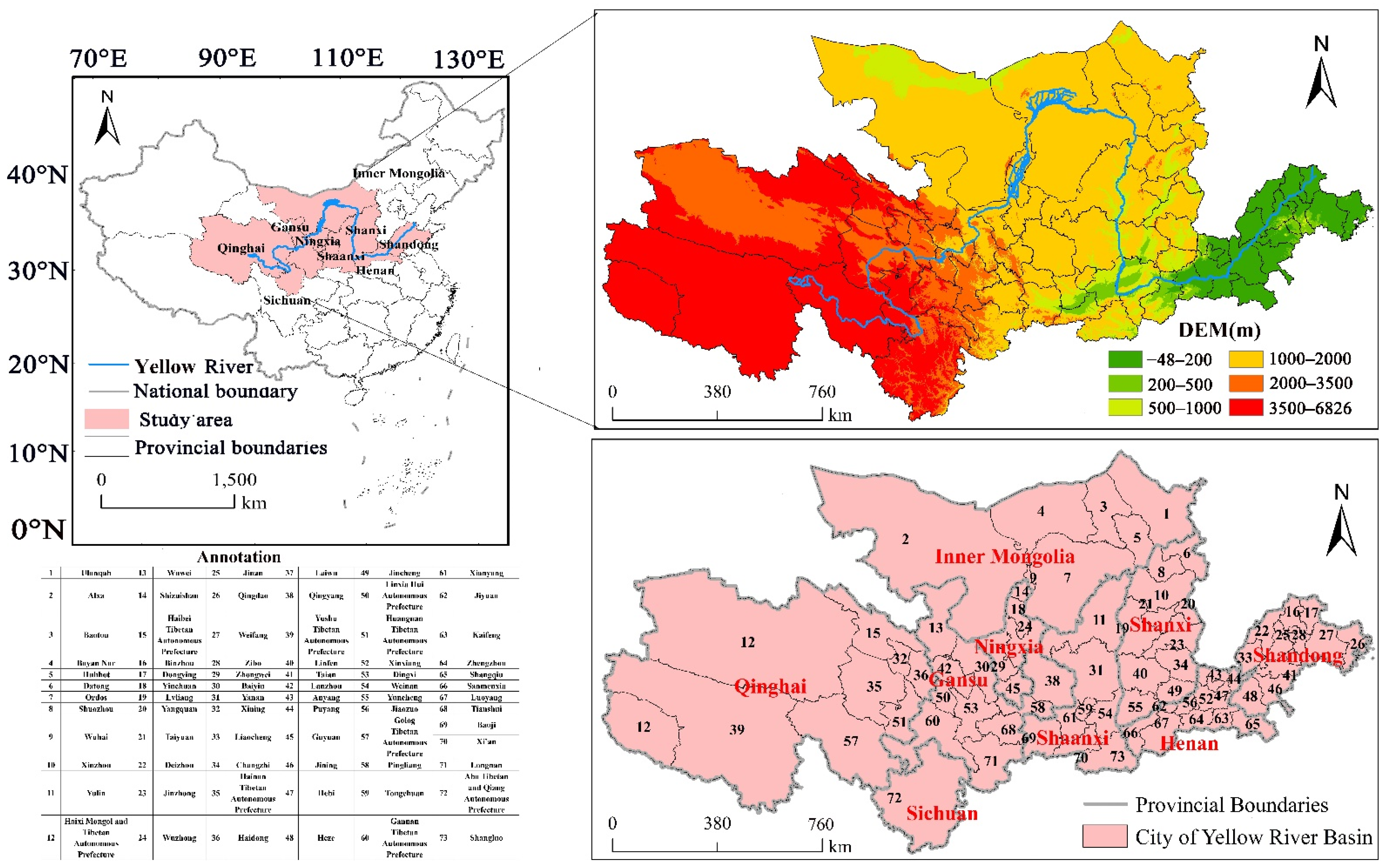
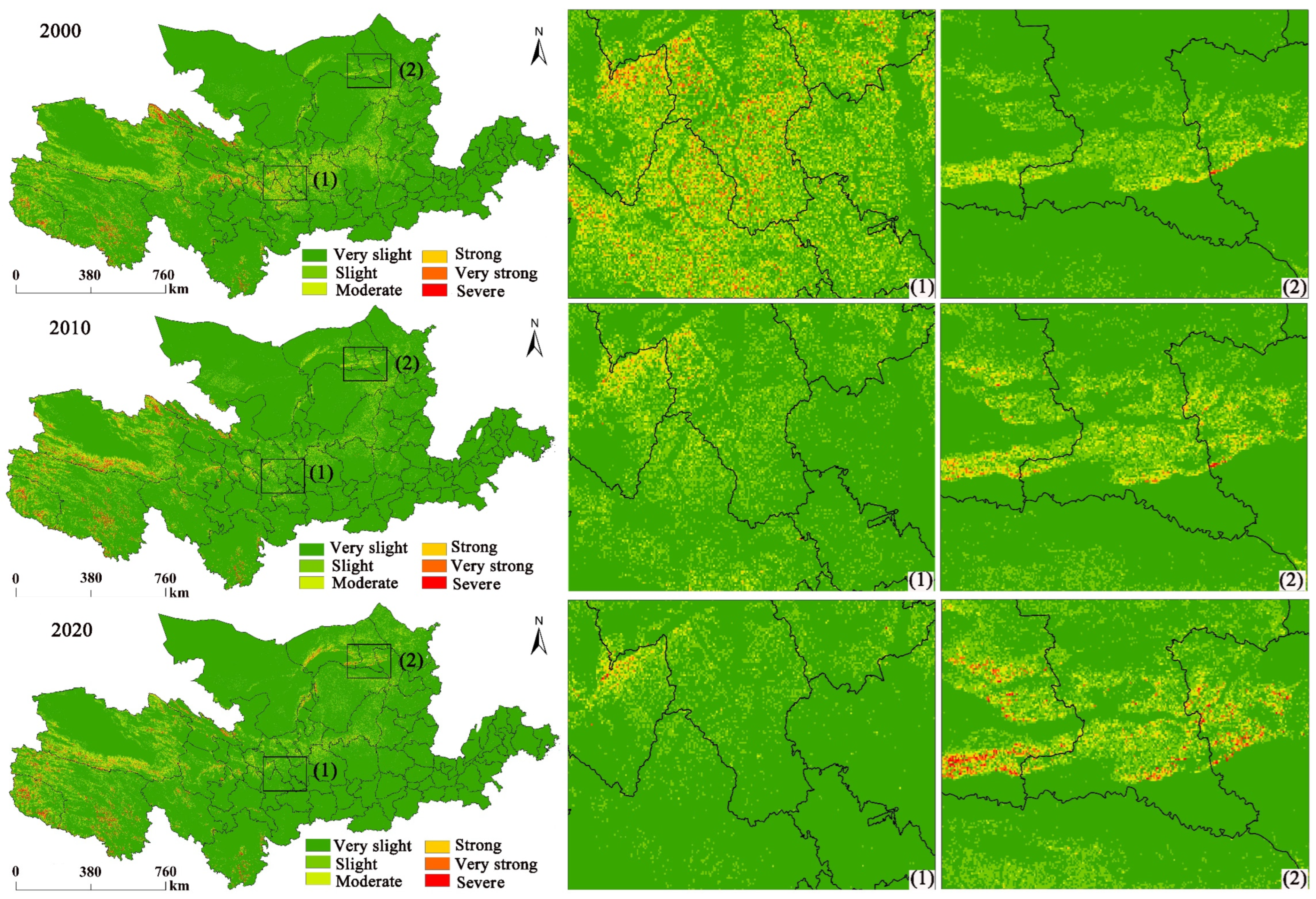

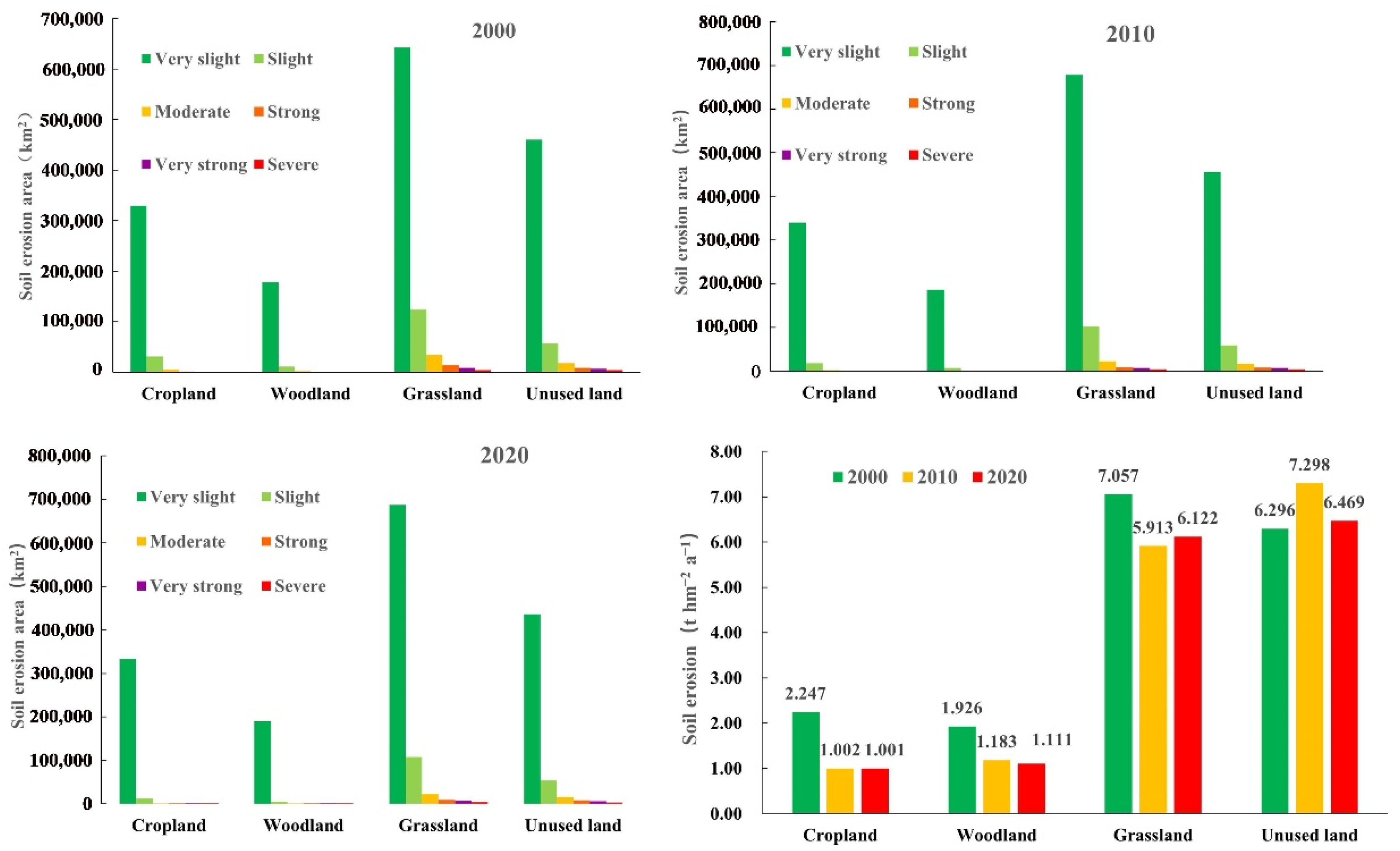
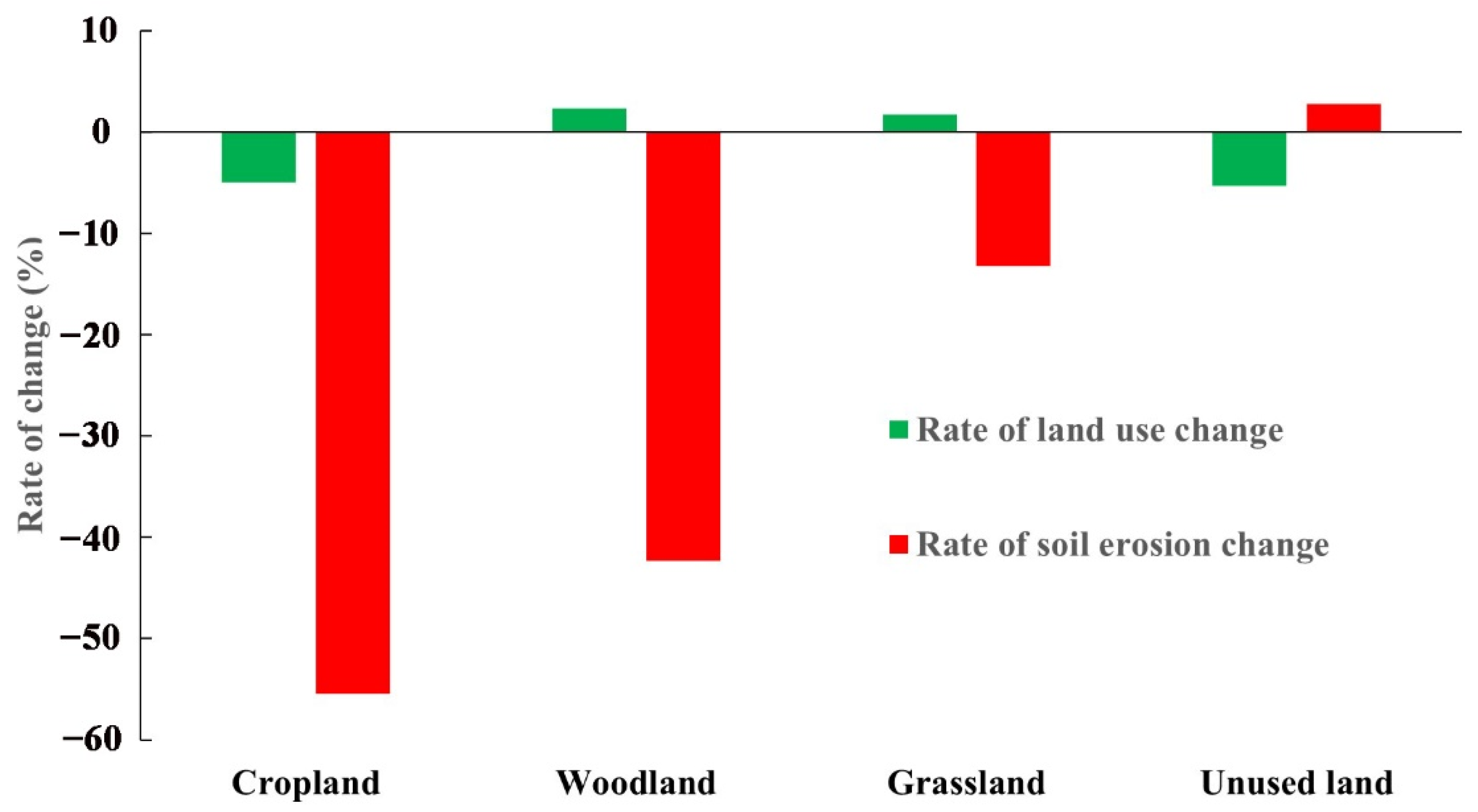

| Data Type | Data Source | Resolution Ratio | Time |
|---|---|---|---|
| DEM | https://earthexplorer.usgs.gov/, accessed on 1 April 2022 | 30 m | |
| LUCC | https://www.resdc.cn, accessed on 1 April 2022 | 1 km | 2000–2020 |
| Soil | https://www.fao.org/land-water/databases-and-software/hwsd/en/, accessed on 5 April 2022 | 1 km | |
| Meteorological | https://data.cma.cn/, accessed on 1 April 2022 | 1 km | 2000–2020 |
| NDVI | https://modis.gsfc.nasa.gov/, accessed on 5 April 2022 | 250 m | 2000–2020 |
| Road | https://www.openstreetmap.org/, accessed on 5 April 2022 | 1 km | 2020 |
| POP | https://www.resdc.cn/, accessed on1 April 2022 | 1 km | 2019 |
| GDP | https://www.resdc.cn/, accessed on1 April 2022 | 1 km | 2019 |
| Year | Soil Erosion (t hm−2 a−1) | Total Soil Erosion (108 t) |
|---|---|---|
| 2000 | 5.28 | 10.13 |
| 2010 | 4.80 | 9.20 |
| 2020 | 4.65 | 8.92 |
| Classification of SE | 2000 | 2010 | 2020 | ||||||
|---|---|---|---|---|---|---|---|---|---|
| Area (106hm2) | SE (t hm−2 a−1) | Amount of SE (108 t) | Area (106hm2) | SE (t hm−2 a−1) | Amount of SE (108 t) | Area (106hm2) | SE (t hm−2 a−1) | Amount of SE (108 t) | |
| Very slight | 172.49 | 1.00 | 1.63 | 178.01 | 0.97 | 1.64 | 178.72 | 0.57 | 0.95 |
| Slight | 22.76 | 11.53 | 2.11 | 19.25 | 11.20 | 1.64 | 18.82 | 11.14 | 1.95 |
| Moderate | 6.09 | 34.81 | 1.85 | 4.44 | 34.90 | 1.34 | 4.28 | 35.19 | 1.40 |
| Strong | 2.42 | 62.24 | 1.35 | 1.92 | 62.67 | 1.08 | 1.93 | 62.92 | 1.13 |
| Very strong | 1.58 | 106.09 | 1.52 | 1.61 | 107.82 | 1.57 | 1.53 | 107.88 | 1.53 |
| Severe | 0.80 | 223.81 | 1.66 | 0.93 | 225.78 | 1.93 | 0.87 | 243.22 | 1.96 |
| Classification of SE | Very Slight | Slight | Moderate | Strong | Very Strong | Severe | Transfer Out |
|---|---|---|---|---|---|---|---|
| Very slight | - | 78,864.79 | 5367.03 | 1988.98 | 1616.99 | 1069.75 | 88,907.54 |
| Slight | 117,494.06 | - | 19,721.04 | 4954.18 | 2016.94 | 654.75 | 144,840.97 |
| Moderate | 22,172.32 | 17,240.72 | - | 6464.73 | 3717.79 | 722.48 | 50,318.04 |
| Strong | 6904.46 | 5685.27 | 3966.14 | - | 3571.57 | 1012.77 | 21,140.20 |
| Very strong | 3337.19 | 2844.78 | 2306.15 | 1973.93 | - | 2349.15 | 12,811.20 |
| Severe | 1286.93 | 814.95 | 757.96 | 841.82 | 1425.62 | - | 5127.28 |
| Transfer in | 151,194.96 | 105,450.50 | 32,118.31 | 16,223.65 | 12,348.90 | 5808.91 | 323,145.23 |
| LUCC | Cropland | Woodland | Grassland | Water area | Built-Up Land | Unused Land | Transfer Out | Total Area in 2020 |
|---|---|---|---|---|---|---|---|---|
| Cropland | - | 18,040 | 75,381 | 5879 | 35,688 | 3472 | 138,460 | 349,076 |
| Woodland | 16,329 | - | 52,217 | 973 | 1974 | 3090 | 74,583 | 197,962 |
| Grassland | 72,178 | 56,200 | - | 12,873 | 8216 | 87,530 | 236,997 | 841,934 |
| Water area | 4815 | 803 | 10,387 | - | 1242 | 5525 | 22,772 | 53,999 |
| Built-up land | 21,537 | 788 | 3639 | 1945 | - | 509 | 28,418 | 61,650 |
| Unused land | 5256 | 3482 | 109,565 | 10,271 | 1985 | - | 130,559 | 525,281 |
| Transfer in | 120,115 | 79,313 | 251,189 | 31,941 | 49,105 | 100,126 | - | |
| Total area in 2000 | 367,435 | 193,489 | 827,843 | 44,699 | 40,903 | 555,023 | - |
| Classification of SE | LUCC | Proportion of Soil Erosion Area (%) | |
|---|---|---|---|
| 2000 | 2020 | ||
| Very slight | Cropland | 89.53 | 95.38 |
| Woodland | 92.06 | 96.10 | |
| Grassland | 77.62 | 81.66 | |
| Unused land | 82.92 | 82.97 | |
| Slight | Cropland | 8.48 | 3.75 |
| Woodland | 5.85 | 2.76 | |
| Grassland | 14.98 | 12.83 | |
| Unused land | 10.38 | 10.40 | |
| Moderate | Cropland | 1.35 | 0.54 |
| Woodland | 1.33 | 0.58 | |
| Grassland | 4.22 | 2.71 | |
| Unused land | 3.21 | 3.00 | |
| Strong | Cropland | 0.41 | 0.15 |
| Woodland | 0.36 | 0.22 | |
| Grassland | 1.62 | 1.16 | |
| Unused land | 1.51 | 1.55 | |
| Very strong | Cropland | 0.10 | 0.05 |
| Woodland | 0.16 | 0.17 | |
| Grassland | 1.00 | 0.93 | |
| Unused land | 1.20 | 1.25 | |
| Severe | Cropland | 0.01 | 0.01 |
| Woodland | 0.06 | 0.06 | |
| Grassland | 0.48 | 0.60 | |
| Unused land | 0.69 | 0.62 | |
| LUCC | Natural Development Scenario | Ecological Protection Scenario |
|---|---|---|
| Cropland | 17.07% | 17.04% |
| Woodland | 10.05% | 10.14% |
| Grassland | 41.74% | 41.85% |
| Water area | 2.67% | 2.67% |
| Built-up land | 3.42% | 3.38% |
| Unused land | 25.06% | 24.91% |
| Soil erosion | 4.81 t hm−2 a−1 | 4.78 t hm−2 a−1 |
Disclaimer/Publisher’s Note: The statements, opinions and data contained in all publications are solely those of the individual author(s) and contributor(s) and not of MDPI and/or the editor(s). MDPI and/or the editor(s) disclaim responsibility for any injury to people or property resulting from any ideas, methods, instructions or products referred to in the content. |
© 2023 by the authors. Licensee MDPI, Basel, Switzerland. This article is an open access article distributed under the terms and conditions of the Creative Commons Attribution (CC BY) license (https://creativecommons.org/licenses/by/4.0/).
Share and Cite
Li, Y.; Zhang, J.; Zhu, H.; Zhou, Z.; Jiang, S.; He, S.; Zhang, Y.; Huang, Y.; Li, M.; Xing, G.; et al. Soil Erosion Characteristics and Scenario Analysis in the Yellow River Basin Based on PLUS and RUSLE Models. Int. J. Environ. Res. Public Health 2023, 20, 1222. https://doi.org/10.3390/ijerph20021222
Li Y, Zhang J, Zhu H, Zhou Z, Jiang S, He S, Zhang Y, Huang Y, Li M, Xing G, et al. Soil Erosion Characteristics and Scenario Analysis in the Yellow River Basin Based on PLUS and RUSLE Models. International Journal of Environmental Research and Public Health. 2023; 20(2):1222. https://doi.org/10.3390/ijerph20021222
Chicago/Turabian StyleLi, Yanyan, Jinbing Zhang, Hui Zhu, Zhimin Zhou, Shan Jiang, Shuangyan He, Ying Zhang, Yicheng Huang, Mengfan Li, Guangrui Xing, and et al. 2023. "Soil Erosion Characteristics and Scenario Analysis in the Yellow River Basin Based on PLUS and RUSLE Models" International Journal of Environmental Research and Public Health 20, no. 2: 1222. https://doi.org/10.3390/ijerph20021222
APA StyleLi, Y., Zhang, J., Zhu, H., Zhou, Z., Jiang, S., He, S., Zhang, Y., Huang, Y., Li, M., Xing, G., & Li, G. (2023). Soil Erosion Characteristics and Scenario Analysis in the Yellow River Basin Based on PLUS and RUSLE Models. International Journal of Environmental Research and Public Health, 20(2), 1222. https://doi.org/10.3390/ijerph20021222






